Who on the Leadership Team Is Accountable for Growth?
Why Growth-Focused Leadership Is Essential in Home-Based Care
Home-based care organizations are built on compassion, dignity and comfort. But to sustain that mission, growth must be part of the equation. Without it, providers risk falling behind, limiting their reach, and ultimately failing to meet the needs of their communities.
While growth may seem like a business-focused concept, it’s deeply connected to patient care. In our experience, a provider that prioritizes growth can expand its services, improve clinical outcomes, and better support families during difficult times. To make that happen, organizations need leaders at the table who are dedicated to driving growth – not just as a function, but as a core part of their strategic vision.

Why Growth Must Have a Seat at the Leadership Table
For many home-based care providers, growth is treated as something that happens naturally – a byproduct of good care and word-of-mouth referrals. But in today’s healthcare landscape, that’s no longer enough.
Home-based care providers face rising costs, workforce challenges and shifting regulations. Growth-focused leadership helps navigate those pressures while ensuring the organization’s mission thrives.
More importantly, growth isn’t just about financial stability – it’s about expanding access to care. Too often, home care and hospice services are underutilized, especially in rural areas and with historically underserved populations. A leader focused on growth will actively seek partnerships, build referral networks, and find creative ways to connect with those who need care the most.
By having a dedicated voice for growth in leadership discussions, home care and hospice organizations can ensure these efforts are not just ideas – they become actionable priorities.

The Role of Growth Leaders in Home-Based Care Organizations
When growth roles – such as a chief growth officer, VP of business development or director of outreach – are part of the leadership team, they bring focus and accountability to the table. Instead of viewing growth as something that happens “when there’s time,” it becomes a deliberate and measurable goal.
Growth leaders should be skilled at building relationships with referral sources, cultivating community partnerships, understanding market trends, and identifying new opportunities to expand services. They can help the entire organization stay proactive, rather than reactive.
But their influence goes beyond just bringing in new referrals. Growth leaders also can help improve internal processes – weighing in with valuable perspectives on optimizing the intake process, helping admissions happen faster, and supporting clinical teams so that they are prepared to handle higher volumes without compromising care quality.
More importantly, they help teams recognize that growth isn’t just a business goal – it’s part of delivering compassionate care to more people in need.

Creating a Sense of Urgency
One of the most important contributions a growth-focused leader can bring, from Transcend’s perspective, is a sense of urgency – a mindset that ensures the team doesn’t wait until tomorrow to fix a broken process or improve communication with referral partners.
For example, if a hospice is struggling to convert referrals into admissions, a strong growth leader will push for faster follow-up, clearer intake protocols, and better communication between departments. They’ll ask questions like:
- Why are families waiting 24 hours for a callback?
- What’s preventing admissions staff from responding in real-time?
- Is our admissions criteria more restrictive than Medicare requires?
- Are we tracking missed opportunities – and learning from them?
This urgency doesn’t mean rushing or cutting corners – it’s about creating a culture where teams understand that every delay can mean a patient isn’t getting the care they need. By emphasizing accountability and results, growth leaders ensure that everyone, from clinical staff to marketing teams, feels invested in census growth and the organization’s overall success.
Home-based care organizations that embrace growth as part of their core strategy – and empower leaders to drive it – are better equipped to meet the needs of their communities. Growth isn’t just about boosting census numbers; it’s about ensuring that no one falls through the cracks when they need care the most.
With growth-focused positions at the leadership table, home care and hospice organizations gain a powerful advantage – a dedicated voice pushing for stronger partnerships, better processes and a deeper commitment to reaching more patients and families. Need help fostering a growth mindset at your organization? We’d welcome a conversation. Reach out at [email protected].











